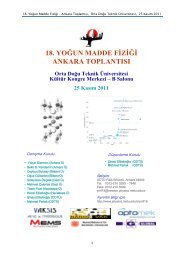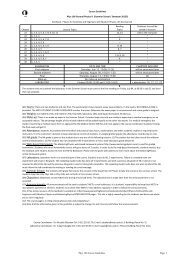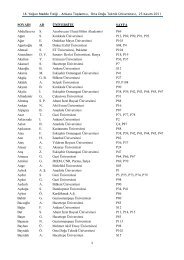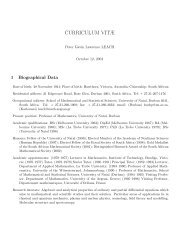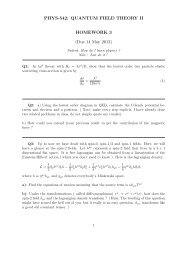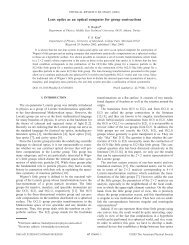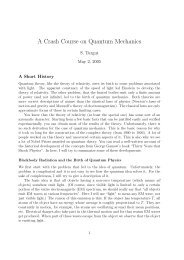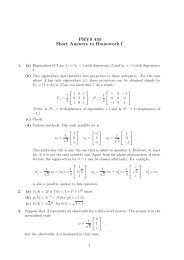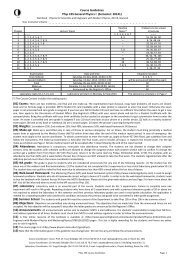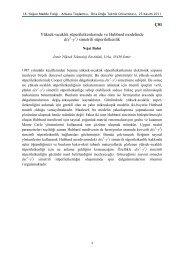Answers to First Midterm Examination 1. Two spin 1/2 particles ...
Answers to First Midterm Examination 1. Two spin 1/2 particles ...
Answers to First Midterm Examination 1. Two spin 1/2 particles ...
Create successful ePaper yourself
Turn your PDF publications into a flip-book with our unique Google optimized e-Paper software.
having a known probability of occurrence, i.e., an ensemble. Describe Alice’sensemble and compute the density matrix ρ of this ensemble.Alice’s ensemble is |ϕ + 〉 = (2 |↑〉 + i |↓〉)/ √ 5 with probability p + = 5/6 and|ϕ − 〉 = |↓〉 with probability p − = 1/6. The density matrix for this ensemble isρ = p + |ϕ + 〉 〈ϕ + | + p − |ϕ − 〉 〈ϕ − |= 5 16 5 (2 |↑〉 + i |↓〉)(2 〈↑| − i 〈↓|) + 1 |↓〉 〈↓|6= 1 ()4 |↑〉 〈↑| − 2i |↑〉 〈↓| + 2i |↓〉 〈↑| + 2 |↓〉 〈↓|6Or in matrix formρ = 1 3[ 2 −ii 1].(d) Is ρ = ρ A (where ρ is the density matrix computed in part (c), and ρ A is thereduced density matrix in part (a))? What does this equality or inequality mean?Yes, ρ = ρ A . Any actions taken by Bob cannot change the density matrix seenby Alice. This implies that no communication can be done by entangled pairs.2. (a) Let ˆn be a unit vec<strong>to</strong>r on the xy-plane in the form ˆn = cos φˆx + sin φŷ where φ isone of the spherical angles of ˆn (the other is θ = π/2). Find σ n = ⃗σ · ˆn.[ ] 0 e−iφσ n = cos φ σ x + sin φ σ y =e iφ .0(b) Find σ n |↑〉 and σ n |↓〉. (You should use the matrix form of σ n above <strong>to</strong> computethese. But the ket expressions in part (b) will be more useful below.)σ n |↑〉 = e iφ |↓〉 , σ n |↓〉 = e −iφ |↑〉 .Consider the following GHZ state of three <strong>spin</strong>s possessed by Alice, Bob and Charlie|GHZ〉 = 1 √2(|↑↑↑〉 − |↓↓↓〉)= 1 √2(|↑〉 A⊗ |↑〉 B⊗ |↑〉 C− |↓〉 A⊗ |↓〉 B⊗ |↓〉 C) .(Note the coefficient of the second term which is different from the one we used inclass.) Let ˆn A , ˆn B and ˆn C be three unit vec<strong>to</strong>rs on the xy-plane having respectiveangles φ A , φ B and φ C .(c) Find (σ AnA ⊗ σ BnB ⊗ σ CnC ) |GHZ〉.(σ AnA ⊗ σ BnB ⊗ σ CnC ) |GHZ〉 = 1 √2(ei(φ A +φ B +φ C ) |↓↓↓〉 − e −i(φ A+φ B +φ C ) |↑↑↑〉 ) .2
(d) The state |GHZ〉 is an eigenstate of σ AnA ⊗ σ BnB ⊗ σ CnC for some angles φ A ,φ B and φ C . For which angles this is the case and what is the correspondingeigenvalue?If σ AnA ⊗ σ BnB ⊗ σ CnC |GHZ〉 = λ |GHZ〉, then we should have−e −i(φ A+φ B +φ C )e i(φ A+φ B +φ C )= λ ,= −λ .Obviously λ = ±1 (either we use λ 2 = 1 derived from above two equations, or usethe fact that the corresponding opera<strong>to</strong>r is hermitian). There are these two cases∗ φ A + φ B + φ C = π (or −π or 3π etc.) for which case the eigenvalue is λ = +<strong>1.</strong>∗ φ A + φ B + φ C = 0 (or ±2π etc.) for which case the eigenvalue is λ = −<strong>1.</strong>If the sum φ A + φ B + φ C is not a multiple of π, then |GHZ〉 is not an eigenstateof the product σ AnA ⊗ σ BnB ⊗ σ CnC .(e) Consider a set of experiments where Alice, Bob and Charlie measure either σ x orσ y on their <strong>spin</strong>s. Describe how the results of these experiments are inconsistentwith local realism.By using the result in part (d): If all three measure σ x , then the product of theirresults must be −<strong>1.</strong> This is because |GHZ〉 is an eigenstate of σ Ax ⊗ σ Bx ⊗ σ Cxwith eigenvalue −<strong>1.</strong>Similarly, if one of them measures σ x and the other two measure σ y (three possibilities:xyy, yxy or yyx), then the product of their results must be +<strong>1.</strong> (Part(d) does not give any definite value of product of results for other cases yyy, xxyetc.)Local realistic theories claim that the result of measurements have definite valueseven if you don’t carry out the measurement. Let us call these values by s Ax , s Ayetc. Then, the results above can be expressed ass Ax s Bx s Cx = −1 ,s Ax s By s Cy = +1 ,s Ay s Bx s Cy = +1 ,s Ay s By s Cx = +1 .However, these expressions are inconsistent as the product of last three equationsgive s Ax s Bx s Cx (s Ay s By s Cy ) 2 = +<strong>1.</strong>3. Let ˆn be an arbitrary unit vec<strong>to</strong>r and let σ n = ⃗σ · ˆn. Remember that σ n has eigenvalues+1 and −1 and |ˆn ↑〉 and |ˆn ↓〉 are the corresponding eigenvec<strong>to</strong>rs. The opera<strong>to</strong>rs P +and P − are defined asP ± = I ± σ n2.3
(a) Find P + |ˆn ↑〉 and P + |ˆn ↓〉. From these obtain an alternative expression of P + inDirac bra-ket notation.P + |ˆn ↑〉 = I + σ n2P + |ˆn ↓〉 = I + σ n2(b) Do the same for P − .|ˆn ↑〉 = 1 + 12|ˆn ↑〉 = |ˆn ↑〉 ,|ˆn ↓〉 = 1 − 1 |ˆn ↓〉 = 0 .( 2P + = P + I = P + |ˆn ↑〉 〈ˆn ↑| + |ˆn ↓〉 〈ˆn ↓|P − |ˆn ↑〉 = I − σ n2P − |ˆn ↓〉 = I − σ n2|ˆn ↑〉 = 1 − 12|ˆn ↓〉 = 1 + 12|ˆn ↑〉 = 0 ,P − = P − I = P −(|ˆn ↑〉 〈ˆn ↑| + |ˆn ↓〉 〈ˆn ↓|)= |ˆn ↑〉 〈ˆn ↑| .|ˆn ↓〉 = |ˆn ↓〉 .)= |ˆn ↓〉 〈ˆn ↓| .(c) Are P ± the projection opera<strong>to</strong>rs for the eigensubspaces of σ n ?Yes since P + = |ˆn ↑〉 〈ˆn ↑| and P − = |ˆn ↓〉 〈ˆn ↓|.(d) Find exp(iθσ n ). Is this a unitary opera<strong>to</strong>r?e iθσn = e iθ P + + e −iθ P − = cos θ + i sin θ σ n .It is unitary since (e iθσ n) † = e −iθσ n= (e iθσ n) −1 .(e) Let ˆn 1 , ˆn 2 , . . . , ˆn k be arbitrary unit vec<strong>to</strong>rs and p 1 , p 2 , . . . , p k be probabilities suchthat p 1 + p 2 + · · · + p k = <strong>1.</strong> Consider the density matrix for the ensemble wherethe state |ˆn j ↑〉 occurs with probability p j . If the density matrix of this ensembleis ρ = (I + ⃗a · ⃗σ)/2, find ⃗a in terms of these unit vec<strong>to</strong>rs and their correspondingprobabilities.We use the expression of P + defined above asThen,ρ =k∑p j |ˆn j ↑〉 〈ˆn j ↑| = 1 2j=1As a result,|ˆn j ↑〉 〈ˆn j ↑| = I + ˆn j · ⃗σ2.(k∑k∑)p j (I + ˆn j · ⃗σ) = 1 2 I + 1 p j ˆn j · ⃗σ .2j=1j=1⃗a =k∑p j ˆn j .j=1Basically, ˆn j are points on the surface of the Bloch sphere and p j is the probabilityof that point. The vec<strong>to</strong>r ⃗a (associated with the density matrix ρ) is just anaverage of these points with the same weights as probabilities.4



